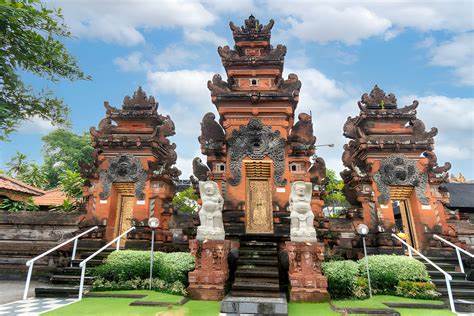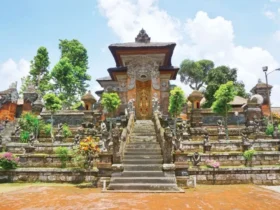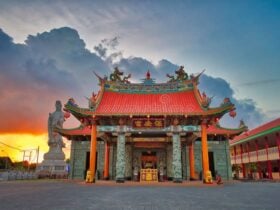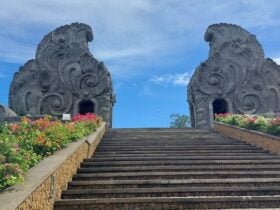Exploring Petitenget Temple, Bali

Petitenget Temple, or Pura Petitenget, is one of the most significant cultural landmarks in Seminyak, Bali. Nestled near the coastline, this ancient Hindu temple is more than just a place of worship; it is a vital piece of Bali’s spiritual and cultural heritage. Known for its sacredness and historical significance, Petitenget Temple is a tranquil retreat from the bustling tourist area of Seminyak and a must-visit for anyone looking to experience Bali’s rich traditions and spirituality.
Despite Seminyak’s reputation for luxury resorts, upscale dining, and lively nightlife, Petitenget Temple stands as a reminder of the area’s deep spiritual roots. With its intricate architecture, traditional ceremonies, and serene ambiance, the temple offers a glimpse into Bali’s ancient culture. This article will guide you through the history, architecture, cultural significance, and what to expect when visiting Petitenget Temple, making it a fascinating stop on your Bali itinerary.
1. History of Petitenget Temple

Petitenget Temple has a long and storied history dating back to the 16th century. It was built as one of the six sea temples established by the revered Hindu priest Dang Hyang Nirartha during his pilgrimage around Bali. These sea temples were strategically placed along the coast to form a spiritual “chain” of protection, safeguarding the island from evil spirits and negative influences coming from the sea. Petitenget, which translates to “magic box” in Balinese, was named after a sacred chest that Nirartha is said to have left behind at the site.
According to local folklore, the temple was built to honor and appease the spirit of Bhuta Ijo, a malevolent sea spirit who was believed to haunt the area. The locals built Petitenget Temple as a way to ward off the spirit’s influence and bring harmony to the region. The temple has since been an important place of worship for the local community, who continue to hold traditional ceremonies and rituals here, especially during special religious occasions.
2. Architecture and Design of Petitenget Temple
The architecture of Petitenget Temple reflects traditional Balinese design, characterized by its use of red bricks and sandstone, ornate carvings, and distinct temple structures. The temple complex is divided into three main areas: the outer courtyard (jaba pisan), the middle courtyard (jaba tengah), and the inner sanctuary (jeroan), where the most sacred rituals are performed.
Entrance and Outer Courtyard
The entrance to Petitenget Temple is marked by a traditional candi bentar, or split gateway, made from red brick and adorned with intricate carvings. As you pass through the gate, you will enter the outer courtyard, where you’ll find various structures, including stone statues, guardian figures, and altars. The statues often depict Raksasa, or guardian spirits, believed to protect the temple from evil forces.
Middle Courtyard
In the middle courtyard, there are several pavilions (bale) used for preparing offerings and ceremonies. This area also contains small shrines and altars dedicated to different deities, as well as spaces where visitors can sit and observe the temple’s beauty. The middle courtyard serves as a transitional space between the outer courtyard and the inner sanctuary, and it is a place where visitors can gain a deeper understanding of Balinese temple rituals.
Inner Sanctuary
The inner sanctuary, or jeroan, is the most sacred part of the temple and is reserved for prayer and worship. It is here that the Padmasana shrine, a central altar dedicated to the supreme deity Sang Hyang Widhi Wasa, can be found. The Meru towers (multi-tiered shrines) located in the inner sanctuary are used for worshiping different gods and spirits, symbolizing the sacred mountain where the deities reside.
The overall design of Petitenget Temple incorporates elements of traditional Balinese cosmology, which emphasizes harmony between the human world, nature, and the spiritual realm. The temple’s serene setting, lush greenery, and intricate carvings make it a beautiful example of Balinese temple architecture.
3. Cultural Significance of Petitenget Temple
Petitenget Temple is not only an important place of worship but also a cultural landmark that holds a special place in the hearts of the local community. The temple plays a central role in the Odalan celebration, which is the temple’s anniversary ceremony held every 210 days according to the Pawukon calendar. The Odalan is a vibrant and colorful event featuring traditional Barong dance performances, gamelan music, and elaborate offerings made from fruits, flowers, and rice. During this time, the temple is decorated with umbul-umbul (traditional Balinese flags), penjor (bamboo poles with offerings), and colorful canopies, creating a lively and festive atmosphere.
In addition to the Odalan, Petitenget Temple hosts various other religious ceremonies, such as Melasti, a purification ritual held before the Balinese New Year (Nyepi), where worshippers gather to bring sacred objects to the sea for cleansing. The temple’s location near the coast makes it an ideal place for such sea-related rituals, which are believed to purify the spiritual essence of the temple and its devotees.
The cultural significance of Petitenget Temple extends beyond religious ceremonies. It represents the enduring connection between the Balinese people, their land, and their spiritual beliefs. Visiting the temple provides insight into the island’s cultural heritage, showcasing the traditional practices that have been passed down for generations.
4. What to Expect When Visiting Petitenget Temple
Visiting Petitenget Temple offers a chance to experience Bali’s spiritual traditions firsthand. Here’s what you should know before you go:
Dress Code
As with all Balinese temples, visitors to Petitenget Temple are required to dress respectfully. This means wearing a sarong and sash to cover your legs and waist, respectively. If you don’t have your own, sarongs and sashes are often available for rent or loan at the temple entrance. Proper attire is a sign of respect for the sacred space and the deities worshipped there.
Entrance Fee
The entrance fee to Petitenget Temple is typically modest, with proceeds used for temple maintenance and community activities. Visitors are encouraged to make donations to support the upkeep of the temple, especially if attending during a ceremony.
Ceremony Etiquette
If you’re fortunate enough to visit Petitenget Temple during a ceremony, be respectful by keeping quiet and observing the rituals from a distance. Visitors are generally welcome to watch, but should not enter the inner sanctuary unless invited. It is also important to avoid obstructing the paths of worshippers or standing in front of the Padmasana shrine, as this is the most sacred part of the temple.
Photography
Photography is usually allowed in the outer and middle courtyards, but visitors should refrain from taking photos of people praying or during certain parts of ceremonies without permission. It’s best to check with temple staff if you are unsure about taking pictures in certain areas.
5. Nearby Attractions and Activities
After visiting Petitenget Temple, there are several other attractions and activities in Seminyak that can enhance your experience:
Petitenget Beach
Just steps away from the temple, Petitenget Beach offers a great place to relax and enjoy the ocean views. The beach is known for its wide stretch of golden sand, excellent surfing conditions, and vibrant sunsets. It’s a popular spot for beachgoers and surfers alike, with beach clubs and cafes nearby for refreshments.
Seminyak’s Famous “Eat Street”
The nearby Jalan Kayu Aya, also known as “Eat Street,” is famous for its array of cafes, restaurants, and boutique shops. Whether you’re in the mood for traditional Indonesian cuisine, fresh seafood, or international dishes, this area has something for everyone. It’s a great place to unwind and enjoy a meal after exploring the temple.
Shopping and Spa Treatments
Seminyak is known for its luxury boutiques and spa services. Take some time to explore the shops, where you’ll find everything from handcrafted jewelry and traditional textiles to high-end fashion. For relaxation, visit one of the many spas in the area offering traditional Balinese massages and beauty treatments.
6. The Best Time to Visit Petitenget Temple
Petitenget Temple can be visited year-round, but it’s especially beautiful during the Odalan festival or Melasti ceremony, when the temple is adorned with decorations and filled with cultural performances. Visiting in the morning or late afternoon provides the most pleasant temperatures and offers the best lighting for photography. The temple is also less crowded during these times, allowing for a more serene experience.
Petitenget Temple is not just a historical site but a living part of Bali’s spiritual and cultural identity. As one of the island’s revered sea temples, it offers visitors an opportunity to connect with Bali’s traditions, observe beautiful rituals, and enjoy a moment of peace in an otherwise lively part of Seminyak. Whether you’re a culture enthusiast, a history buff, or simply someone looking to experience the sacred side of Bali, Petitenget Temple is a must-visit destination that captures the essence of the island’s heritage.










Leave a Review